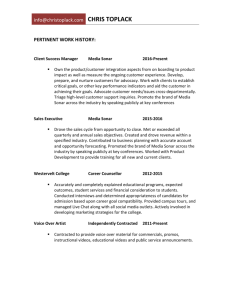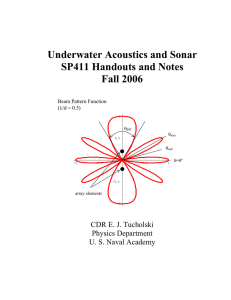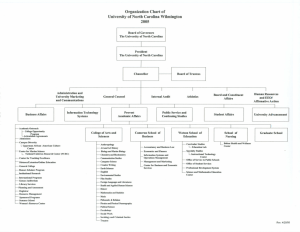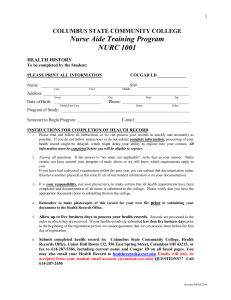10:00 2aUW4. My personal perspective of sonar research at the NATO... 共Kitzeberger Strasse 兲
advertisement
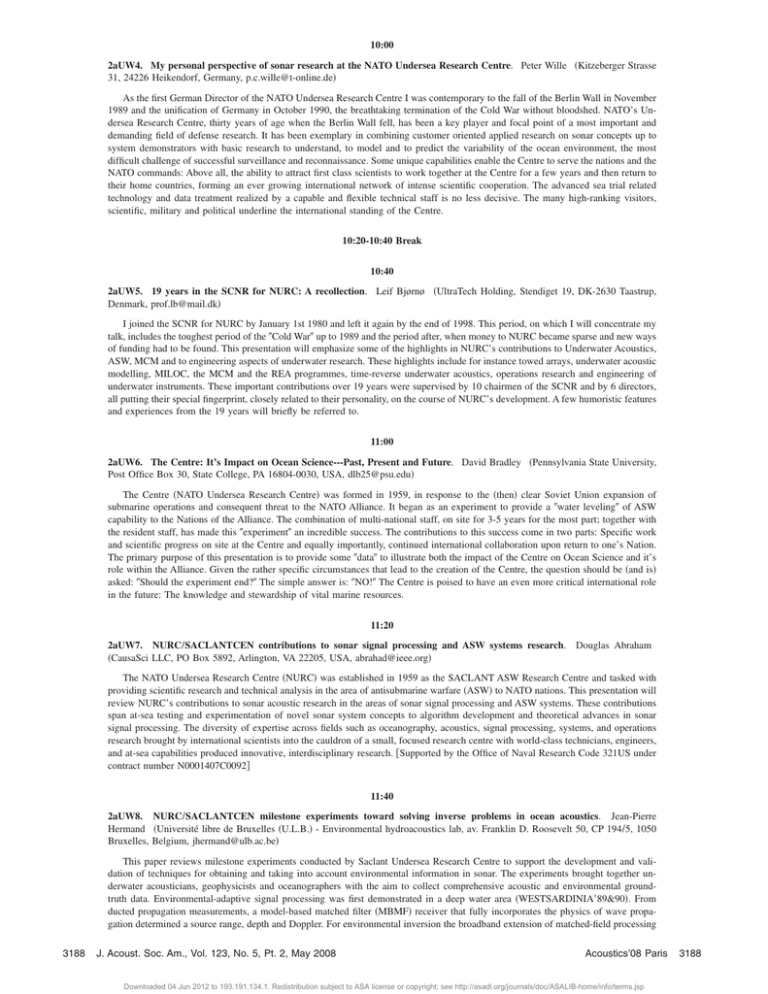
10:00 2aUW4. My personal perspective of sonar research at the NATO Undersea Research Centre. Peter Wille 共Kitzeberger Strasse 31, 24226 Heikendorf, Germany, p.c.wille@t-online.de兲 As the first German Director of the NATO Undersea Research Centre I was contemporary to the fall of the Berlin Wall in November 1989 and the unification of Germany in October 1990, the breathtaking termination of the Cold War without bloodshed. NATO’s Undersea Research Centre, thirty years of age when the Berlin Wall fell, has been a key player and focal point of a most important and demanding field of defense research. It has been exemplary in combining customer oriented applied research on sonar concepts up to system demonstrators with basic research to understand, to model and to predict the variability of the ocean environment, the most difficult challenge of successful surveillance and reconnaissance. Some unique capabilities enable the Centre to serve the nations and the NATO commands: Above all, the ability to attract first class scientists to work together at the Centre for a few years and then return to their home countries, forming an ever growing international network of intense scientific cooperation. The advanced sea trial related technology and data treatment realized by a capable and flexible technical staff is no less decisive. The many high-ranking visitors, scientific, military and political underline the international standing of the Centre. 10:20-10:40 Break 10:40 2aUW5. 19 years in the SCNR for NURC: A recollection. Leif Bjørnø 共UltraTech Holding, Stendiget 19, DK-2630 Taastrup, Denmark, prof.lb@mail.dk兲 I joined the SCNR for NURC by January 1st 1980 and left it again by the end of 1998. This period, on which I will concentrate my talk, includes the toughest period of the ⬙Cold War⬙ up to 1989 and the period after, when money to NURC became sparse and new ways of funding had to be found. This presentation will emphasize some of the highlights in NURC’s contributions to Underwater Acoustics, ASW, MCM and to engineering aspects of underwater research. These highlights include for instance towed arrays, underwater acoustic modelling, MILOC, the MCM and the REA programmes, time-reverse underwater acoustics, operations research and engineering of underwater instruments. These important contributions over 19 years were supervised by 10 chairmen of the SCNR and by 6 directors, all putting their special fingerprint, closely related to their personality, on the course of NURC’s development. A few humoristic features and experiences from the 19 years will briefly be referred to. 11:00 2aUW6. The Centre: It’s Impact on Ocean Science---Past, Present and Future. David Bradley 共Pennsylvania State University, Post Office Box 30, State College, PA 16804-0030, USA, dlb25@psu.edu兲 The Centre 共NATO Undersea Research Centre兲 was formed in 1959, in response to the 共then兲 clear Soviet Union expansion of submarine operations and consequent threat to the NATO Alliance. It began as an experiment to provide a ⬙water leveling⬙ of ASW capability to the Nations of the Alliance. The combination of multi-national staff, on site for 3-5 years for the most part; together with the resident staff, has made this ⬙experiment⬙ an incredible success. The contributions to this success come in two parts: Specific work and scientific progress on site at the Centre and equally importantly, continued international collaboration upon return to one’s Nation. The primary purpose of this presentation is to provide some ⬙data⬙ to illustrate both the impact of the Centre on Ocean Science and it’s role within the Alliance. Given the rather specific circumstances that lead to the creation of the Centre, the question should be 共and is兲 asked: ⬙Should the experiment end?⬙ The simple answer is: ⬙NO!⬙ The Centre is poised to have an even more critical international role in the future: The knowledge and stewardship of vital marine resources. 11:20 2aUW7. NURC”SACLANTCEN contributions to sonar signal processing and ASW systems research. Douglas Abraham 共CausaSci LLC, PO Box 5892, Arlington, VA 22205, USA, abrahad@ieee.org兲 The NATO Undersea Research Centre 共NURC兲 was established in 1959 as the SACLANT ASW Research Centre and tasked with providing scientific research and technical analysis in the area of antisubmarine warfare 共ASW兲 to NATO nations. This presentation will review NURC’s contributions to sonar acoustic research in the areas of sonar signal processing and ASW systems. These contributions span at-sea testing and experimentation of novel sonar system concepts to algorithm development and theoretical advances in sonar signal processing. The diversity of expertise across fields such as oceanography, acoustics, signal processing, systems, and operations research brought by international scientists into the cauldron of a small, focused research centre with world-class technicians, engineers, and at-sea capabilities produced innovative, interdisciplinary research. 关Supported by the Office of Naval Research Code 321US under contract number N0001407C0092兴 11:40 2aUW8. NURC”SACLANTCEN milestone experiments toward solving inverse problems in ocean acoustics. Jean-Pierre Hermand 共Université libre de Bruxelles 共U.L.B.兲 - Environmental hydroacoustics lab, av. Franklin D. Roosevelt 50, CP 194”5, 1050 Bruxelles, Belgium, jhermand@ulb.ac.be兲 This paper reviews milestone experiments conducted by Saclant Undersea Research Centre to support the development and validation of techniques for obtaining and taking into account environmental information in sonar. The experiments brought together underwater acousticians, geophysicists and oceanographers with the aim to collect comprehensive acoustic and environmental groundtruth data. Environmental-adaptive signal processing was first demonstrated in a deep water area 共WESTSARDINIA’89&90兲. From ducted propagation measurements, a model-based matched filter 共MBMF兲 receiver that fully incorporates the physics of wave propagation determined a source range, depth and Doppler. For environmental inversion the broadband extension of matched-field processing 3188 J. Acoust. Soc. Am., Vol. 123, No. 5, Pt. 2, May 2008 Acoustics’08 Paris Downloaded 04 Jun 2012 to 193.191.134.1. Redistribution subject to ASA license or copyright; see http://asadl.org/journals/doc/ASALIB-home/info/terms.jsp 3188
